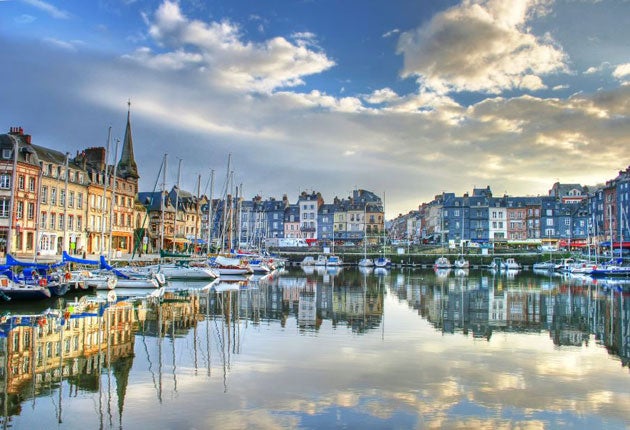Trail of the unexpected: Honfleur
Now is the time to visit Honfleur, Normandy's coastal gem.

Your support helps us to tell the story
From reproductive rights to climate change to Big Tech, The Independent is on the ground when the story is developing. Whether it's investigating the financials of Elon Musk's pro-Trump PAC or producing our latest documentary, 'The A Word', which shines a light on the American women fighting for reproductive rights, we know how important it is to parse out the facts from the messaging.
At such a critical moment in US history, we need reporters on the ground. Your donation allows us to keep sending journalists to speak to both sides of the story.
The Independent is trusted by Americans across the entire political spectrum. And unlike many other quality news outlets, we choose not to lock Americans out of our reporting and analysis with paywalls. We believe quality journalism should be available to everyone, paid for by those who can afford it.
Your support makes all the difference.Fishing ports don't come any prettier. Ancient houses of mellow stone line the perimeter of a sheltered harbour, the water of which is haunted by their reflections. Set back at either side of the shimmering haven, two tall church spires pierce the skyline. Behind them tangles of cobbled lanes spread around a hill graced by terraces of gracious gabled mansions and timber-framed houses. It's with good reason Honfleur is said to be the jewel of Normandy's coast.
So far, so perfect. But inevitably there's a downside: Honfleur – on the south bank of the Seine estuary, opposite the port of Le Havre– is hardly undiscovered. Most of the year you'll share this picture postcard with hordes of others.
Yet go there now and you'll see Honfleur without the crowds. During February and much of March, you'll walk those cobbled alleyways unhindered by dithering tourists. The cafés lining that stunningly attractive old harbour – the Vieux Bassin – will be sleepy. You won't find the full and impressive gamut of Honfleur's gourmet restaurants open during the low season, but several factors outweigh this inconvenience. The crisp winter light for a start. Then there's the ease with which you'll be able to take in the rich history. And today the town's four museums reopen after their annual winter closure.
Despite its tiny size, Honfleur was once an important seafaring centre, playing a major part in the Hundred Years War. And it was also from here that Samuel de Champlain sailed out to found Quebec in 1608. The launch of his small fleet is commemorated by a bust of the great explorer that sits together with a plaque by the old harbour wall.
By the mid 18th century, the effects of silting had put an end to the town's maritime importance. However, although it lost its status as a port, Honfleur gradually became rich artistically. Thanks to the quality of light, numerous painters were attracted here, from English watercolourists such as William Turner to the Impressionists.
Start an absorbing tour by ambling over to the church of Sainte-Catherine off the northern side of the Vieux Bassin. This week you may have this fabulous building to yourself. It was made entirely of wood during the 15th century. Honfleur's shipwrights played a big part in the construction, devising a roof like the hull of a ship – you see the similarities clearly as you walk around the interior.
You'll also get an intriguing insight into life in old Honfleur at two extraordinary museums on the southern side. They're housed in wonderfully creaky old buildings that look as if they've barely changed from the Middle Ages. The 14th-century church of St Etienne is now the little Musée Maritime. Tucked under stained-glass windows are displays of charts, knots, sea chests and ship-builder's models.
Adjacent to this is the Musée d'Ethnographie. Inside is a celebration of domestic life, with nine rooms kitted out as interior sets from the 18th and 19th centuries, complete with dressers, grandfather clocks and mirrors.
Honfleur's finest sights are a short walk from the harbour. Meander north along the old alleyways and head for a remarkable art gallery filled with masterpieces depicting the estuary. Landscape painter Eugène Boudin was born in Honfleur in 1824. It was at a small art shop in Le Havre that he met the young Claude Monet and became his mentor, bringing him to Honfleur. He drew others to the town, too, among them Johan Jongkind. Set in a 19th-century chapel, Musée Eugène Boudin displays many of works, including Monets, paintings by Jongkind and works by artists Paul-Elie Gernez and Raoul Dufy.
Just downhill, an elegant house on Boulevard Charles V was the early home of the avant garde composer Erik Satie, born here in 1866. Maisons Erik Satie is now a brilliant museum. An ingenious English audio tour takes you into the fantastical world of the composer: his music, theories, art and wit. He was a true eccentric, and the museum is almost as wacky as the man himself. You're confronted with a giant pear with wings on entering and the last exhibit is a crazy musical merrygoround devised from original plans by Satie. It's as uplifting as a glass of Calvados by the old harbour.
Travel essentials
Getting there
* Le Havre is served by twice-daily ferries from Portsmouth, operated by LD Lines (0844 576 8836; ldlines.co.uk). Two bus services (numbers 20 and 39) link Le Havre and Honfleur daily. For timetables, see busverts.fr
More information
Join our commenting forum
Join thought-provoking conversations, follow other Independent readers and see their replies
Comments